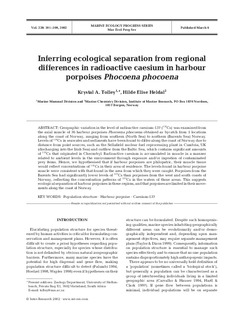Inferring ecological separation from regional differences in radioactive caesium in harbour porpoises Phocoena phocoena
Journal article, Peer reviewed
Permanent lenke
http://hdl.handle.net/11250/108334Utgivelsesdato
2002-03-06Metadata
Vis full innførselSamlinger
- Articles [3012]
Originalversjon
http://dx.doi.org/10.3354/meps228301Sammendrag
Geographic variation in the level of radioactive caesium-137 (Cs-137) was examined from the axial muscle of 36 harbour porpoises Phocoena phocoena obtained as bycatch from 5 locations along the coast of Norway, ranging from southern (North Sea) to northern (Barents Sea) Norway. Levels of Cs-137 in seawater and sediments have been found to differ along the coast of Norway due to distance from point sources, such as the Sellafield nuclear fuel reprocessing plant in Cumbria, UK (discharging into the Irish Sea) and outflow from the Baltic Sea, which contains significant amounts Of Cs-137 that originated in Chernobyl. Radioactive caesium is accumulated in muscle in a manner related to ambient levels in the environment through exposure and/or ingestion of contaminated prey items. Hence, we hypothesised that if harbour porpoises are philopatric, their muscle tissue would reflect concentrations Of Cs-137 in their area of residence. The levels found in harbour porpoise muscle were consistent with that found in the area from which they were caught. Porpoises from the Barents Sea had significantly lower levels of Cs-137 than porpoises from the west and south coasts of Norway, reflecting the concentration patterns of Cs-137 in the waters of those areas. This suggests ecological separation of harbour porpoises in these regions, and that porpoises are limited in their movements along the coast of Norway.
